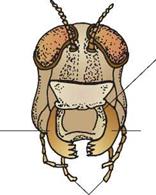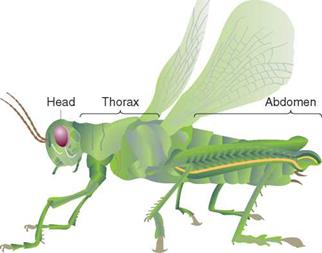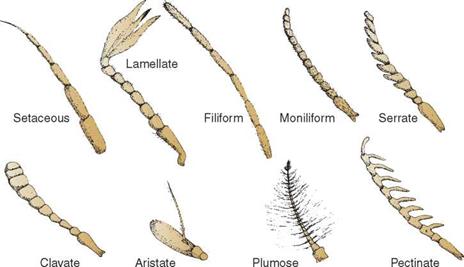In the animal kingdom, the major divisions are known as phyla (singular phylum). The phylum Arthropoda contains the class Insecta, or the insects. Other classes of Arthropoda include the crayfish, spiders, centipedes, ticks, millipedes, mites, and scorpions. Certain of the noninsect Arthropoda are important as plant pests, especially the mites, but the plant pests that represent the greatest numbers and do the greatest amount of economic damage are the true insects.
Anatomy of Insects
Combining the characteristics of all members of the phylum Arthropoda with those unique to the class Insecta, the external anatomy of insects features:
• jointed appendages
• bilateral symmetry
• an exoskeleton
• three body divisions (head, thorax, and abdomen)
• six legs attached to the thorax
• wings (usually two pairs) attached to the thorax
• one pair of antennae attached to the head
• simple and compound eyes
• reproductive organs in the abdomen
• air tubes for respiration
The external anatomy of a typical insect is exemplified by the grasshopper (Figure 6-1). Several of the anatomical features warrant special mention.
Exoskeleton The exoskeleton is the hard protective covering of the insect’s body. It functions like our more familiar endoskeleton, serving as the point of attachment for muscles. It also protects the softer
|
|
figure 6-і. The external anatomy of a typical insect is exemplified by the grasshopper. (Delmar/Cengage Learning)
tissues inside. The exoskeleton has helped ensure the survival of insects through centuries of evolution and environmental stress. Excessive moisture, severe drying, and enemies of all types are thwarted by it. The exoskeleton is composed principally of chitin, a nitrogenous polysaccharide compound that resists water, alcohol, acids, and alkalis.
Head The head bears the mouthparts, eyes, and antennae. Sensory perception is the function of the antennae, and they are one of the major distinguishing features in the identification of insects. Following are nine of the more common types of insect antennae (Figure 6-2).
1. pectinate: comb-like
2. plumose: feather-like
3. setaceous: tapering to a point
4. serrate: saw-like
5. lamellate: expanded thin plates at the tips
6. aristate: enlarged at the tip and bearing a bristle
7. clavate: club-like
8. filiform: thread-like; uniform the entire length
9. moniliform: bead-like
The type of mouthpart is also highly important in identifying insects and equally so in selecting a means of controlling them. The mouth- parts of insects determine how they feed on plants and the symptoms of injury that are manifested. These are the most common types of mouthparts (Figure 6-3).
• chewing: The mouth can tear, chew, and grind food. Examples: grasshopper and beetles.
• siphoning: The mouthpart is like a coiled tube. It is dipped into a liquid food, which is then drawn in. Examples: moths and butterflies.
• sponging: Two sponge-like structures collect the liquid food and move it to the insect’s food canal. Example: housefly.
|
figure 6-2. Typical insect antennae (Courtesy Cari Goetcheus) |
Labrum (upper lip)
![]()

![]()
 Not shown: labium (lower lip;
Not shown: labium (lower lip;
behind the mouth)
Mandible (jaw)
(cuts, tears, and chews foods)
Proboscis————-
![]() (a long drinking tube formed from modified maxillae; it uncoils to suck liquids)
(a long drinking tube formed from modified maxillae; it uncoils to suck liquids)
figure 6-3. All insect mouthparts are modifications of two main types: chewing (left) and sucking (right). (Delmar/Cengage Learning)
• rasping-sucking: The mouthpart rasps (breaks) the surface of the plant, then sucks the sap that exudes from the wound. Example: thrips.
• piercing-sucking: The mouth punctures the epidermis of plants, then sucks the sap. Examples: aphids, scale, leafhoppers.
• chewing-lapping: The insect is able to tear and chew the plant tissue as well as draw up released liquid through a temporary food tube. Example: bees.
 |
Legs The legs project from the thorax. They and the wings propel insects in a variety of ways. They vary as widely as antennae and mouth – parts (Figure 6-4).
Wings The wings also arise from the thorax. Unlike the legs, the number (six) of which is part of the very definition of an insect, the number of wings can vary. Most adult insects have two pairs; some have only one pair; and still other insects have no wings. The venation pattern of the wings is a factor in the identification of insects.
Digestive system The digestive system is a tube that extends from the mouth of the insect to the anus. It is divided into three parts: the fore-intestine, mid-intestine, and hind-intestine. Food is digested in the mid-intestine.
Respiratory system The respiratory system combines expansion and contraction of the abdomen with diffusion to exchange oxygen and carbon dioxide in the cells and tissues of the insect. Insects breathe through small openings along the side of the thorax and abdomen termed spiracles. The spiracles open into tracheae, tubes that carry essential oxygen directly to the cells and tissues. Carbon dioxide passes out of the tissues by a reversal of the process.
Nervous system The nervous system is made up of groups of specialized cells called ganglia (singular, ganglion) and nerve fibers that join the ganglia to other parts of the insect’s body. The insect’s brain is simply an enlarged ganglion located in the head.
Reproductive system The reproductive system is located in the abdomen. Reproduction normally requires mating between a male and female, although some insects are incapable of reproduction. Still others are able to reproduce through parthenogenesis which allows eggs to develop even though they have not been fertilized.
In addition to the reproductive organs common to most animals, insects possess specialized organs for mating and depositing eggs. The male insect may have special structures for clasping the female. The female has an ovipositor, an organ for laying eggs.




